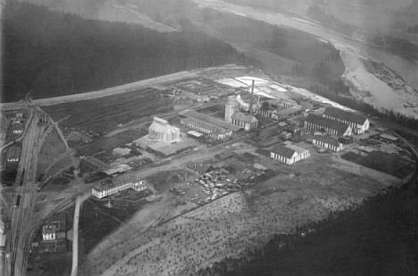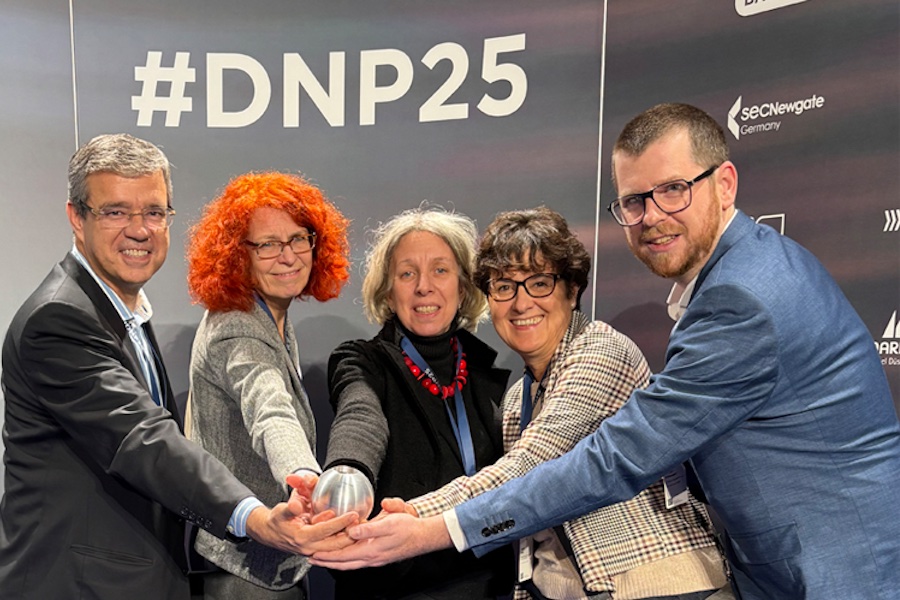#Textile chemistry
WACKER celebrates Centennial
In 1918, Bavaria’s King Ludwig III visited the new WACKER site. The king is at the picture’s center foreground at right, with Alexander Wacker at left. The entrepreneur Alexander Wacker was born in Heidelberg in 1846. Trained as a businessman, Wacker had initially joined forces with Sigmund Schuckert to spread electrification across Germany. In 1903, he established the “Consortium für elektrochemische Industrie,” which today is WACKER’s corporate research department. His aim was to use electrochemical processes to manufacture useful chemical compounds based on carbide and its derivative, acetylene.
In 1914, Wacker received approval for the construction of a hydro-electric power plant and of a canal that would join the Alz and Salzach rivers. In his search for a suitable location, he chose a site close to the town of Burghausen (Bavaria). This site featured a 63-meter gradient between the Alz and the Salzach, which could be used to generate electricity. That same year he also founded “Alexander Wacker Gesellschaft für elektrochemische Industrie”: the origin of the WACKER Group. It was from this company that Wacker-Chemie GmbH (until 2005) and today’s Wacker Chemie AG (since 2006) would eventually emerge.
The first facilities within the Burghausen plant took advantage of the methods developed at the Consortium for synthesizing acetaldehyde, acetic acid and acetone. The direct oxidation of acetylene to acetaldehyde, a process licensed worldwide, played a crucial role. Acetone, which was needed in large quantities for making synthetic rubber, was the principal sales driver in the fledgling company’s early years. Acetylene also provided the chemical basis for further products. Polyvinyl acetate, polyvinyl alcohol and polyvinyl chloride were all derived from acetylene chemistry.
In the 1940s, work began on two new product groups, both based on the element silicon: 1947 saw the dawn of the silicone era in Burghausen. Metallurgical-grade silicon was soon also used as a raw material for the manufacture of another key product: hyperpure silicon for the semiconductor industry.
Polymer chemistry also made great strides in the post-war years. In the early 1950s, WACKER chemists developed the principles for producing dispersible polymer powders for dry-mix mortars, which today are an integral part of many tile adhesives, plasters and building-insulation systems. In 1957, the first dispersible polymer powder production plant went on stream. Copolymers and terpolymers were additionally developed in quick succession. They considerably extended the range of properties and applications of dispersions. A milestone was achieved in 1960, when vinyl acetate-ethylene copolymer (VAE) was discovered. This discovery made it possible to produce inexpensive plastics with innovative properties.
Over subsequent years, WACKER entered new territory, thanks to its advances in acetylene chemistry and innovations in silicon chemistry.
In the late 1960s, WACKER became the first major manufacturer of silicones in Europa to successfully penetrate the US market. Well-established business with vinyl plastics boomed as well. As a result, experts started to wonder whether the energy-intensive and comparatively expensive production of carbide-derived acetylene could be replaced by a new, more cost-effective process based on Petroleum.
The switch was ultimately achieved at the end of the 1950s in what became the “Second WACKER Process,” using ethylene as the starting product for acetic acid.
WACKER’s focus in the 1970s and 1980s was all about increasing exports. This period witnessed the establishment of a great many subsidiaries both in Europe (the Netherlands, Austria, Switzerland, Belgium, Sweden, the UK and Spain) and overseas (Brazil, Mexico and the USA). WACKER entered the Asian market in 1983, when it founded Wacker Chemicals East Asia in Tokyo.

Pic: The WACKER site in Burghausen today: With 10,000 employees, the Burghausen site is one of the largest production sites in the Group.

Pic: Aerial view of the WACKER site in Burghausen in 1920.
In the 1990s, WACKER began to develop biotechnology as a new business field. A biotech research center began work in Burghausen in 1990. The acquisition of ProThera GmbH in Jena and the establishment of Wacker Biotech GmbH in 2005 expanded the Group’s existing pharmaceutical operations to include the contract development of pharmaceutical proteins (biologics). WACKER acquired Halle-based Scil Proteins Production in 2013. The Halle site produces pharmaceutical actives both for clinical trials and for the market-supply phase.
Entering the 21st century, WACKER continues to make progress on the Group’s internationalization. Major sites have been established in Europe, Asia and the USA. In 1998, WACKER acquired the Nünchritz chemical site in the German state of Saxony. WACKER began producing silicones in China in 2004. WACKER and Samsung decided to jointly construct a fab for the manufacture of 300 mm semiconductor wafers in 2006. This fab went on stream just 18 months later. In 2008, WACKER and Dow Corning launched the world’s largest integrated production site for siloxane in Zhangjiagang, China. 2011 saw the Group embark on the construction of a further polysilicon production plant in Charleston, Tennessee, USA.
The Group’s shareholder structures changed during this ti











